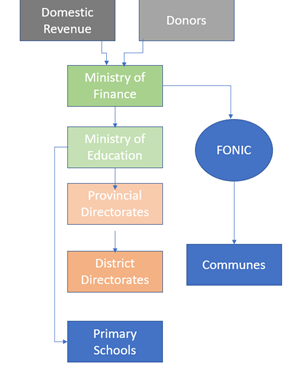FINANCING FOR EQUITY
1. Overall Education Financing Mechanisms
2. Policies and Programmes to Provide Resources to Schools
3. Education Policies and Programmes to Provide Resources to Students and Families
4. Social Policies and Programmes to Provide Resources to Students and their Families
Basic education (6 years of primary and 3 years of secondary) is compulsory and 6 years of primary education are free. Students cover expenditures such as uniforms and textbooks.
In 2018, Burundi spent 5.01% of its GDP and 19.92% of its budget on education. The country has a school aged population of 5.23million people. Sixty-five percent of students are enrolled in public schools, one third in grant-aided schools (i.e. government subsidized), 4% in private schools and 1% in community schools.
The central government is responsible for payment of the salaries for the DPE, the DCE, the inspections offices and teachers. The Ministry allocates funds to schools, as well as provincial and communal offices based on the number of schools. Budget planning is centralized by the Ministry of Education who is responsible for payment of the salaries for the Provincial Education Directorates (DPE), the Commune Education Directorates (DCE), the inspections offices, and teachers. The Ministry of Education allocated funds based on the number of schools and the number of students: US$ 0.30 cents (BIF 500) per trimester. The funds cover operational costs and schools’ grants to primary schools.
Communes also have a planning process that is not coordinated with the Ministry of education and that is funded by the National Investment Funds for Communes (FONIC) that covers construction and rehabilitation of primary and secondary schools. The FONIC’s fund for development projects (including health and education) provides US$ 250,000 (BIF 500 million per commune per year.

Source: https://www.unicef.org/esa/media/6066/file/UNICEF_%26_World_Bank_Burundi-Education_PER-2019.pdf
The education sector plan’s component 3 is dedicated to providing support to school resilience and reduction of vulnerabilities (Composante 3 - Appui à la résilience des écoles et réduction des vulnérabilités) targeted to the education of girls, refugees, and out of school children. This component is costed at US$ 813 978 or 9% of the education sector programmed expense for 2020 and is expected to impact 110,000 students or 0.02% of the school aged population.
School feeding programme (school canteen)
Since 1999, Implemented by the Ministry of Education, funded by the social protection budget and supported by the World Food Program, the program is targeted to selected primary schools based on the worst food security and primary education indicators. Between 2016 and 2017, a program targeted 548,000 learners in 456 primary schools with an estimated budget allocation of US$15 million. It grew from 2012 when it represented 9.7% of the social protection budget and reached 187 000 students or 3.56% of the school aged population.
Inclusive Education Unit
It is a unit within the Ministry of Education addressing students with special needs. In 2015, they identified 8000 students (0.15% of school age population) as possible beneficiaries and have begun 6 pilot programs to offer basic education. Albeit little, US$ 520 (BIF 1million) has been designated to this program.
Higher education scholarships - They represented US$ 5.8million (BIF 11.3billion) or 36.5% of social protection expenditures.
Child Protection Committees
The National Solidarity Ministry with the support of UNICEF and NGOs has helped set up 743 committees and the local level to protect children and connect them to an integrated package of services for orphan children including: educational (school kits), training, health, nutrition, psychosocial and legal services.
The number of children receiving school kits in 2012 was 42 300 (0.8% of the school aged population) and school feeding and school kits represented 12% of the social protection budget.








